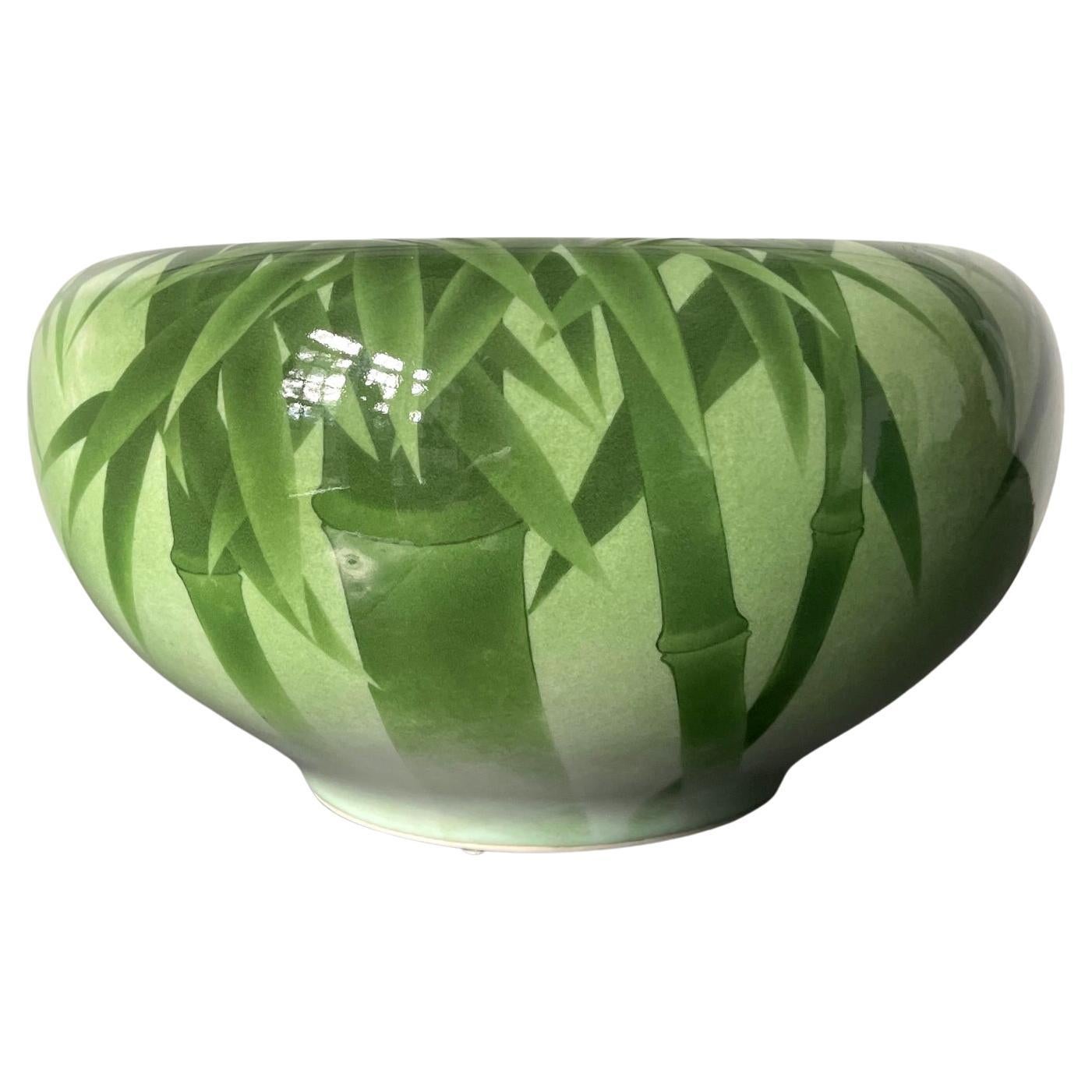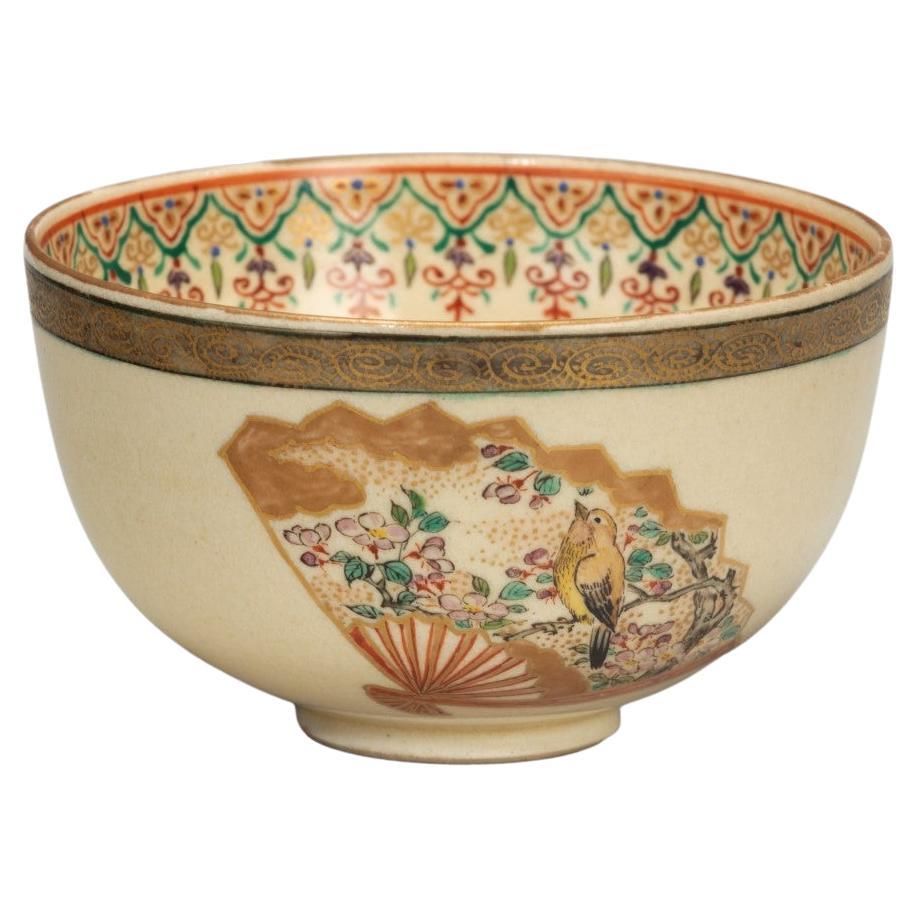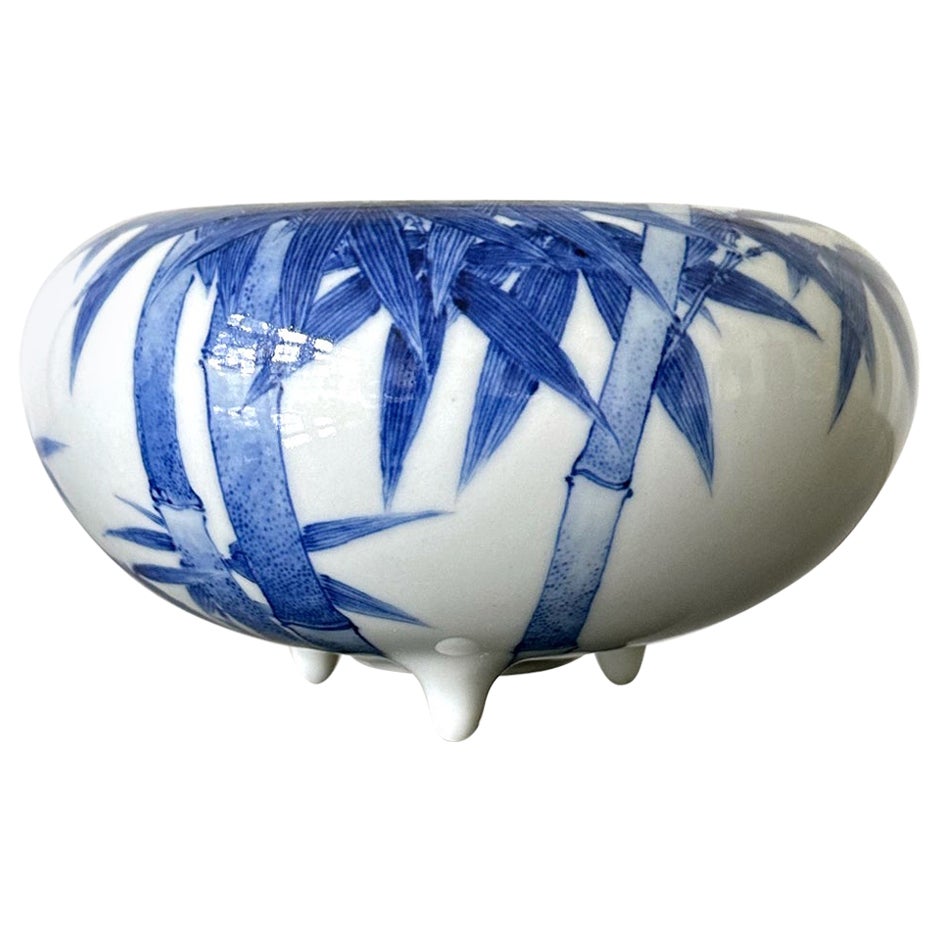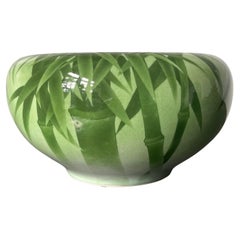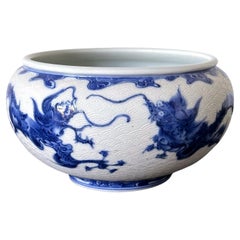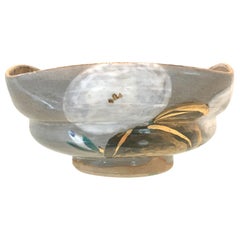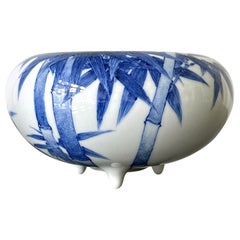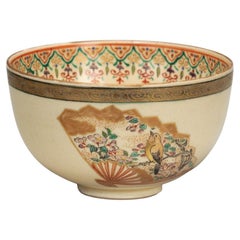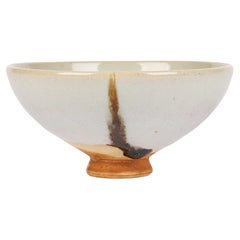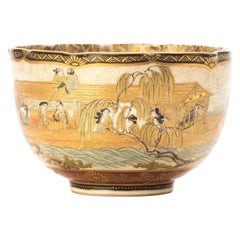Items Similar to Rare Japanese Ceramic Glazed Bowl Makuzu Kozan Meiji Period
Want more images or videos?
Request additional images or videos from the seller
1 of 16
Rare Japanese Ceramic Glazed Bowl Makuzu Kozan Meiji Period
$10,800
£8,257.17
€9,510.60
CA$15,134.11
A$16,895.81
CHF 8,853.15
MX$206,821.32
NOK 112,435.11
SEK 106,012.04
DKK 70,978.57
About the Item
On offer is a rare ceramic bowl with overglazed design by the famed Japanese ceramic artist Makuzu Kozan (1842-1916), circa 1906-1916. The bowl is rather unusual from the potter's repertoire with its unique glaze colors and decoration, and it likely belonged to a small series that Kozan made in and after 1906. A bowl of similar glaze and nearly identical dragon motif was recorded as a diplomatic present to the British royalty Arthur Connaught (1883-1932) when he represented King Gorge V in Japan in 1906. Other pieces, such as this bowl, were likely made with similar materials and designs afterwards.
Essentially round in form, the bowl has a generous volume with six harmonious lobes. The bottom of the interior showcases a coiled dragon in red, green and gold slithering on a cobalt blue background. The roundel shares an echoing lobed perimeter, which is further outlined by red and turquois bands and rising sun design. The exterior of the bowl features six stylized Japanese camellias in full bloom, red with gold outline. Toward the base, the space was divided into alternate lotus petal shapes centered with designs resembling coins and sea creatures. The overglaze colors were rather unusual, especially the bright cobalt blue and turquois, both far from conventional, even for the potter who was known to use western chemical colors in his work to create new look. The dragon design on the bottom of the bowl, is essentially identical to the dragon motif on the more elaborate bowl presented to Connaught.
On the base, the piece is signed in a red archaic kanji seal "Made by Makuzu Kozan".
Makuzu Kozan, also known as Miyagawa Kozan (1842-1916), one of the most established and collected ceramist from Meiji Period. Born as Miyagawa Toranosuke, Kozan established his pottery studio in Yokohama circa 1870s and later became one of the appointed artist to the Japanese Imperial household. His work was exhibited in many international fairs that the Meiji government participated at the turn of the century and won many grand prizes.
Makuzu Kozan, also known as Miyagawa Kozan, was one of the most established and collected ceramists from Meiji Period. Born as Miyagawa Toranosuke, Kozan established his pottery studio in Yokohama circa 1870s and later became one of the appointed artist to the Japanese Imperial household. His work was exhibited in many international fairs that the Meiji government participated at the turn of the century and won many grand prizes.
Reference: for two pieces in the same series aforementioned see page 144-146 of the book: Sekai ni Aisa Reta ya Kimono Miyagawa Kozan Makuzu Ware (Japanese Edition).
- Creator:Makuzu Kozan (Artist)
- Dimensions:Height: 4 in (10.16 cm)Diameter: 11 in (27.94 cm)
- Style:Japonisme (Of the Period)
- Materials and Techniques:
- Place of Origin:
- Period:1900-1909
- Date of Manufacture:1900-1910
- Condition:Wear consistent with age and use. Fine condition, a couple of horizonal fine surface scratches on the lower lobe of the exterior as shown.
- Seller Location:Atlanta, GA
- Reference Number:1stDibs: LU945023214802
About the Seller
4.9
Platinum Seller
Premium sellers with a 4.7+ rating and 24-hour response times
Established in 2006
1stDibs seller since 2010
565 sales on 1stDibs
Typical response time: <1 hour
- ShippingRetrieving quote...Shipping from: Atlanta, GA
- Return Policy
Authenticity Guarantee
In the unlikely event there’s an issue with an item’s authenticity, contact us within 1 year for a full refund. DetailsMoney-Back Guarantee
If your item is not as described, is damaged in transit, or does not arrive, contact us within 7 days for a full refund. Details24-Hour Cancellation
You have a 24-hour grace period in which to reconsider your purchase, with no questions asked.Vetted Professional Sellers
Our world-class sellers must adhere to strict standards for service and quality, maintaining the integrity of our listings.Price-Match Guarantee
If you find that a seller listed the same item for a lower price elsewhere, we’ll match it.Trusted Global Delivery
Our best-in-class carrier network provides specialized shipping options worldwide, including custom delivery.More From This Seller
View AllJapanese Ceramic Centerpiece Bowl Makuzu Kozan Meiji Period
By Makuzu Kozan
Located in Atlanta, GA
A beautiful ceramic vessel in the form of Bo, the so-called monk's alms bowl from the studio of Japanese Potter Makuzu Kozan, also known as Miyagawa Kozan (1842–1916), one of the most established and collected ceramist from Meiji Period. Born as Miyagawa Toranosuke, Kozan established his pottery studio in Yokohama circa 1870s and later became one of the appointed artists to the Japanese Imperial household. His work was exhibited in many international fairs that the Meiji government participated at the turn of the century and won many grand prizes.
Of a relatively large size, this piece was made as a decorative center piece for display. It was brilliantly decorated with underglaze paint of a green-on-green bamboo motif, using the novel technique developed by Kozan called Fuki-e (the blow painting). As a result, the bamboos appear took on a three-dimensional quality as if appearing in a mist. Known as one of the most creative ceramists, circa 1887, Kozan started experimenting with new chemical colors from the West in the format of his porcelain glaze. New colors allowed him to create underglaze design that appeared bright, smooth and glossy. To create design that is realistic and dimensional, more common in the western paintings, he was inspired by the native Japanese ink painting technique developed around 1900 by Yokoyama Taikan...
Category
Antique Early 1900s Japanese Japonisme Ceramics
Materials
Ceramic
Japanese Glazed and Caved Ceramic Dragon Bowl by Makuzu Kozan
By Makuzu Kozan
Located in Atlanta, GA
A ceramic bowl by Japanese Imperial potter Makuzu Kozan (1842-1916) circa 1891 of late Meiji period. A very fine example of the artist's work that belongs to the middle period of his...
Category
Antique Late 19th Century Japanese Meiji Ceramics
Materials
Ceramic
Japanese Ceramic Bowl Makuzu Kozan Utusushi Kenzan
By Makuzu Kozan
Located in Atlanta, GA
A rare ceramic bowl with overglaze paint decoration by Japanese imperial potter Makuzu Kozan ((1842–1916). Unlike the better-known works Kozan made for the expositions in the west and export to the foreign market, this piece exemplifies his work for the domestic market and the tea ceremony. The bowl was made in the so called "Utusushi" Ogata Kenzan (1663-1743), a celebrated Edo painter and ceramicist. Utusushi is loosely translated as "in the spirit of". It is not at all a simple imitation of a master, but a Japanese concept of embracing the spiritual essence of a master while the creator is free to mix in his or her own unique artistic interpretation and flavor.
The bowl was made to hold fruits during the tea ceremony. It has a very distinguished form with a circular lower body morphing into a square upper portion that further opening with flared rim. The surface has a grey glaze onto which Asagao flowers (Japanese morning glory) on the vines were painted in a free and poetic style. White was used for the petals, green for the leaves with touches of gold highlight. Asagao, the symbol of the summer was rendered in the spirit of Ogata Kenzan, and interestingly the shape of the blossom echoes the unique form the bowl. It was likely reserved for the tea ceremony during the summer months.
Under the base, Kozan was signed in black on a white porcelain plaque inlay.
For two similar examples of Kozan's work Utusushi Kenzan, see Page 168-169 of the book: Sekai ni Aisa Reta ya Kimono Miyagawa Kozan Makuzu...
Category
Antique Early 1900s Japanese Japonisme Ceramics
Materials
Ceramic
Japanese Glazed Ceramic Bowl by Makuzu Kozan
By Makuzu Kozan
Located in Atlanta, GA
Tri-pod ceramic bowl likely used as an incense burner (koro) by Japanese Imperial potter Makuzu Kozan (1842-1916) circa late Meiji period. The signature indicates that it was produce...
Category
Antique 1880s Japanese Meiji Ceramics
Materials
Ceramic
Japanese Glazed Stoneware Bowl by Kitaoji Rosanjin Ex-Musuem Collection
By Rosanjin Kitaoji
Located in Atlanta, GA
A stoneware round bowl with dramatic glaze made by Kitaoji Rosanjin (1883-1959) circa first half of the 20th century. The low height bowl with wide opening and swell body resembles a...
Category
Mid-20th Century Japanese Modern Ceramics
Materials
Ceramic
Japanese Glazed Kyo-yaki Tea Bowl Nin'ami Dohachi Edo Period
Located in Atlanta, GA
A Japanese chawan (tea bowl) of Kyo-yaki (Kyoto ware) attributed to Nin'ami Dōhachi, also known as Takahashi Dōhachi (1783–1855). Potted sensitively wi...
Category
Antique 19th Century Japanese Edo Decorative Bowls
Materials
Ceramic
You May Also Like
Small Satsuma Earthenware Bowl
Located in Lymington, Hampshire
A small Satsuma earthenware bowl, painted in overglaze enamels and gilt with three fans. Japanese, circa 1900.
Measures: Height 2 inches Diamete...
Category
Antique Early 1900s Japanese Ceramics
Materials
Ceramic
Chinese Jun Ware Streak Glazed Art Pottery Bowl
Located in Bishop's Stortford, Hertfordshire
A very stylish good quality Chinese Jun Ware pottery bowl decorated with streaked glazes on a red and pale blue glazed ground dating from the latter 19th o...
Category
Antique 19th Century Chinese Other Ceramics
Materials
Pottery
A Japanese Satsuma ceramic lobed bowl
Located in Milano, IT
Satsuma ceramic lobed bowl with curved corners and embellished with a refined scene of daily life along a watercourse on the outside. The interior is adorne...
Category
Antique Late 19th Century Japanese Japonisme Ceramics
Materials
Ceramic
$3,213 Sale Price
20% Off
Large Japanese Satsuma Bowl, 19th Century
Located in London, GB
Meticulously enamelled and gilt with different scenes satsuma bowl.
Category
Antique Late 19th Century Japanese Ceramics
Materials
Porcelain
$3,265 Sale Price
20% Off
Antique Japanese Arita Porcelain Bowl Japan Top Quality, ca 1670-1690
Located in Amsterdam, Noord Holland
A lovely antique bowl from Arita, Japan. The outside wall with an ongoing landscape scene and the inside also with a nice landscape scene in a circle.
Additional information:
Materi...
Category
Antique 17th Century Japanese Decorative Bowls
Materials
Porcelain
$1,699 Sale Price
20% Off
Small Satsuma Earthenware Tea Bowl
Located in Lymington, Hampshire
A small Satsuma earthenware tea bowl, the speckled greyish body decorated with four panels of alternating bijinand flowers, painted in overglaze en...
Category
Antique Early 1900s Japanese Ceramics
Materials
Ceramic
More Ways To Browse
Rare Glazed
Rare Bowl
Blue Glaze Japan
Antique Japanese Seals
Red Ceramic Bowl
Pottery Bowl Japan
Antique Japanese Book
Gold Ceramic Bowl
Japanese Bowl Signed
Japanese Blue Bowl
Ceramic Dragons
Asian Coins
Japanese Meiji Bowl
Japanese Cobalt Blue Ceramics
Meiji Period Bowl
Cobalt Blue Bowl Antique
Japanese Blue Dragon
Japanese Green Pottery
